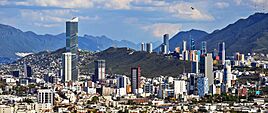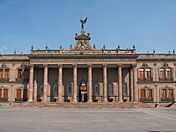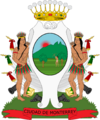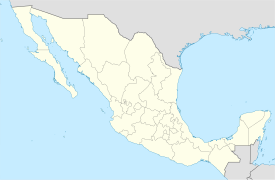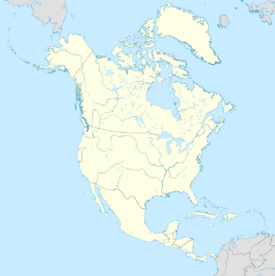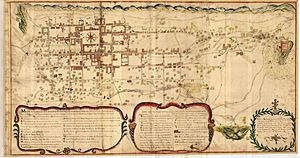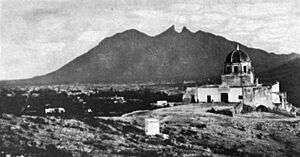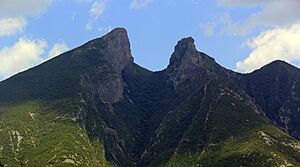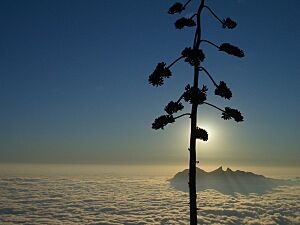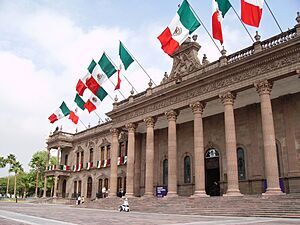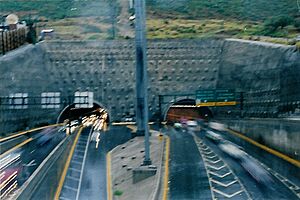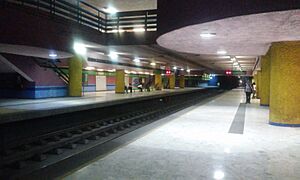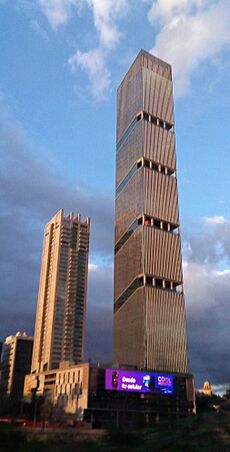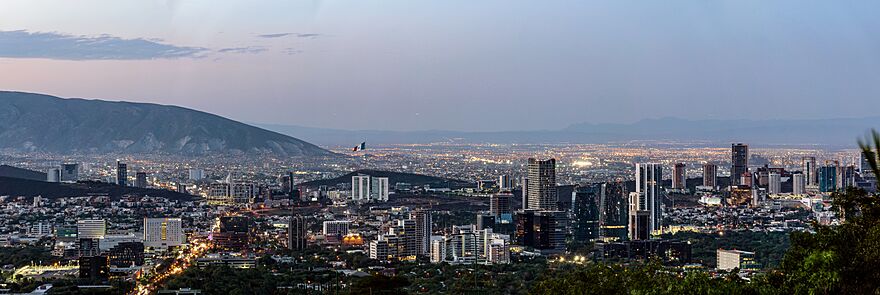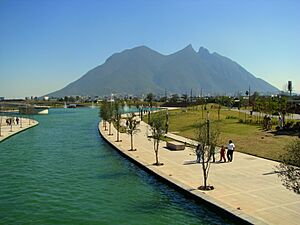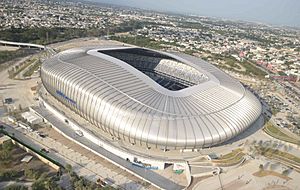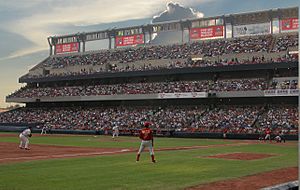Monterrey facts for kids
Quick facts for kids
Monterrey
|
|||
|---|---|---|---|
|
Skyline of Monterrey and San Pedro Garza García
|
|||
|
|||
| Nicknames:
Sultan of the North, City of the Mountains, Mexican Industrial Capital
|
|||
| Motto(s):
Work Tempers the Spirit
|
|||
| Country | |||
| State | |||
| Municipality | Monterrey | ||
| Founded | September 20, 1596 | ||
| Founded as | Ciudad Metropolitana de Nuestra Señora de Monterrey (English translation: Metropolitan city of Our Lady of Monterrey) | ||
| Founded by | Diego de Montemayor | ||
| Named for | Gaspar de Zúñiga, 5th Count of Monterrey | ||
| Area | |||
| • City | 324.8 km2 (125.4 sq mi) | ||
| • Urban | 958 km2 (370 sq mi) | ||
| • Metro | 7,657.5 km2 (2,956.6 sq mi) | ||
| Elevation | 540 m (1,770 ft) | ||
| Population
(2020)
|
|||
| • City | 1,142,952 | ||
| • Rank | 23rd in North America 9th in Mexico |
||
| • Density | 3,415/km2 (8,845/sq mi) | ||
| • Urban | 5,324,281 | ||
| • Urban density | 4,500/km2 (11,600/sq mi) | ||
| • Metro | 5,341,177 | ||
| Demonym(s) | Regiomontano(a) Regio(a) |
||
| GDP (PPP, constant 2015 values) | |||
| • Year | 2023 | ||
| • Total (Metro) | $190.3 billion | ||
| • Per capita | $37,200 | ||
| Time zone | UTC−6 (CST) | ||
| The words Ciudad de Monterrey shown on the flag and seal translate to "City of Monterrey" in English. | |||
Monterrey is a big city in northeastern Mexico. It is the capital of the state of Nuevo León. It's known as a major business and industrial center in North America. The city is also the most populated in Northern Mexico.
Monterrey is part of a larger area called the Monterrey metropolitan area. This area is the second largest in Mexico. It has about 5.3 million people. The city itself has over 1.1 million residents.
Many people consider Monterrey one of the best cities to live in Mexico. A study in 2018 found that its suburb, San Pedro Garza García, has the best quality of life in the country. Monterrey is a key place for trade in northern Mexico. Many big international companies have their main offices here.
The city was first settled by Diego de Montemayor in 1596. After Mexico became independent, Monterrey grew into an important business hub. Its economy really took off after the Monterrey Foundry was built in 1900. Today, Monterrey is famous for industries like steel, cement, glass, car parts, and brewing. Its strong economy is partly because it's close to the United States border.
Contents
- What's in a Name? The Meaning of Monterrey
- A Look Back: Monterrey's History
- Exploring Monterrey: Geography and Nature
- People and Learning: Demographics and Education
- How Monterrey is Governed
- Getting Around: Transportation in Monterrey
- Money and Business: Monterrey's Economy
- Fun and Flavor: Monterrey's Culture
- Famous Faces: Notable People from Monterrey
- City Friends: Twin Towns and Sister Cities
- Images for kids
- See also
What's in a Name? The Meaning of Monterrey
The city of Monterrey is named after Gaspar de Zúñiga, 5th Count of Monterrey. He was an important leader in New Spain from 1595 to 1603. His family came from a place called Monterrei in Spain.
A Look Back: Monterrey's History
Early Times: Before Europeans Arrived
Before Europeans came, the area where Monterrey is now was home to different groups of nomadic people. These groups moved around a lot. Historians have found Carved stone and cave paintings in the mountains nearby. These artworks show that four main groups lived here: the Azalapas, Huachichiles, Coahuiltecos, and Borrados.
How Monterrey Was Founded
In the 1500s, the valley of Monterrey was mostly unknown to Spanish explorers. The first attempts to settle here were not successful. Spanish explorers were attacked by native groups and had to leave.
Later, a Spanish explorer named Luis Carvajal y de la Cueva got permission from King Philip II to create a new territory. This area in northern New Spain was called Nuevo León, or the "New Kingdom of León." In 1582, he started a small settlement called San Luis Rey de Francia in the Monterrey area.
After some time, the area was left empty for eight years. Then, in 1596, Diego de Montemayor led 13 families to the area. They officially founded the city on September 20, 1596. They named it Ciudad Metropolitana de Nuestra Señora de Monterrey. This means "Metropolitan City of Our Lady of Monterrey." It was built near a water spring called Ojos de Agua de Santa Lucia. Today, the Museum of Mexican History and the Santa Lucía riverwalk are in this spot.
During the time Spain ruled, Monterrey stayed a small city. It helped with trade between places like San Antonio (now in Texas), Tampico, and Saltillo.
Growing Up: After Mexican Independence
In the 1800s, after Mexico became independent from Spain, Monterrey grew into an important economic center. This was because it had good trade connections to Europe, the United States, and Mexico City. In 1824, the "New Kingdom of León" became the state of Nuevo León, and Monterrey was chosen as its capital.
The city saw some tough times with wars and political changes. In 1846, a major battle of the Mexican–American War happened here. It was called the Battle of Monterrey. Mexican forces fought hard but eventually had to surrender.
By 1890, a very important local company, the Cervecería Cuauhtémoc brewery, was founded.
The 1900s: Industrial Boom and Big Events
In the late 1800s, railroads connected Monterrey, which helped its industries grow even faster. A steel company, Fundidora de Fierro y Acero de Monterrey, was founded in 1900. It became one of the biggest in the world and sped up the city's industrial growth.
Monterrey also hosted some big events. In 1986, it was one of the cities for the 1986 FIFA World Cup soccer games. In 1988, Hurricane Gilbert caused a lot of damage. The Santa Catarina River, which is usually dry, overflowed and caused floods.
The 2000s: Global Meetings and Natural Challenges
In the 21st century, Monterrey has hosted important international events. In 2002, the United Nations held a big conference here. In 2004, the OAS also had a summit in the city.
In 2010, Hurricane Alex hit Monterrey. It brought record-breaking rain and caused severe flooding. This storm was even worse than Hurricane Gilbert. The city has been working on rebuilding and improving since then.
In 2022, Monterrey faced a serious drought. Water service was limited for many weeks. The government is working on solutions to improve the water supply for the future.
Exploring Monterrey: Geography and Nature
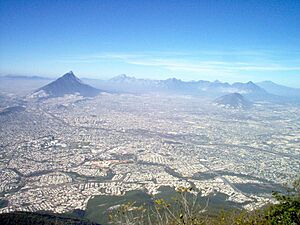

Monterrey is located about 540 meters (1,772 feet) above sea level. The name "Monterrey" means "King Mount" or "King Mountain." This name fits well because the city is surrounded by large mountains.
The Santa Catarina River flows through Monterrey from east to west. Most of the year, the riverbed is dry on the surface, but water flows underground.
Monterrey is surrounded by other cities like San Nicolás de los Garza, García, General Escobedo, Guadalupe, and San Pedro Garza García. Together, these cities form a large metropolitan area.
The city sits north of the Sierra Madre Oriental mountain range. You can see several famous mountains around Monterrey:
- The Cerro del Topo and Topo Chico are smaller hills in the northern suburbs.
- The Cerro de las Mitras (Mountain of the Mitres) is to the west. Its shape looks like several bishops wearing their special hats called mitres.
- Cerro de la Silla (Saddle Mountain) is a major symbol of the city. It dominates the view to the east.
- The Cerro del Obispado (Bishopric Hill) is north of the river. It has a historic building called the Bishopric Palace.
Natural Wonders and Parks
The mountains around Monterrey are full of canyons, trails, and forests. Many of these areas are open to the public for outdoor activities. The Sierra Madre Oriental mountains south of the city are part of the "Parque Nacional Cumbres de Monterrey." This park is recognized by UNESCO for its natural importance.
Some popular natural spots include:
- Parque Ecológico Chipinque: A park with beautiful forests, mainly oak and pine trees.
- La Estanzuela state park: A river and forest area about 7 kilometers (4.3 miles) south of Monterrey.
- La Huasteca: An area west of the city, popular for climbing.
- Garcia Caves: These amazing caves were found in 1843. Inside, you can see incredible rock formations called stalagmites and even snail fossils.
- Cascade Cola de Caballo: A spectacular waterfall in Santiago, Nuevo León. It's formed by water flowing down from the mountains of the Cumbres de Monterrey National Park.
Weather in Monterrey
Monterrey has a semi-arid climate. This means it doesn't get a lot of rain, especially in winter. Summers are usually very hot, while spring and fall are mild. Winters are generally cool, and temperatures rarely drop below freezing.
- In August, the average high temperature is about 36°C (97°F).
- In January, the average high is around 22°C (72°F).
Rainfall is more common from May to September. Monterrey can have sudden weather changes. For example, it can sometimes reach 30°C (86°F) in January, which is one of the coldest months. Snow is very rare, but it has happened, like in January 1967 when 20 inches (51 cm) fell in 8 hours. The most recent snowfall was in February 2021.
In July 2010, Hurricane Alex caused the worst natural disaster in the city's history. It brought over 584 mm (23 inches) of rain in just 72 hours. This amount of rain is usually what the city gets in a whole year! The storm destroyed homes and roads, and many families were left without water.
People and Learning: Demographics and Education

Most of the people in the state of Nuevo León live in the Monterrey metropolitan area. This area is the second most populated in Mexico, with over 5 million residents. It includes Monterrey and several nearby cities like Apodaca, Guadalupe, and San Pedro Garza García.
Learning and Universities
Monterrey has a very low rate of people who cannot read or write. The city has many public libraries with a large collection of books for its residents.
Monterrey is home to several important universities:
- The Universidad Autónoma de Nuevo León (UANL) is one of Mexico's largest universities. Its main campus, Ciudad Universitaria, is huge. UANL has many colleges, high schools, and a medical school that is considered one of the best in Latin America.
- The Instituto Tecnológico y de Estudios Superiores de Monterrey (Monterrey Institute of Technology and Higher Studies), often called Tec de Monterrey, is a highly-ranked private university. It's known for its strong programs in engineering and social sciences.
- The Universidad Regiomontana was founded in 1969 with support from local companies. It offers many programs and has agreements with universities around the world.
- The Universidad de Monterrey was founded by religious groups and Catholic citizens.
How Monterrey is Governed
Monterrey and its surrounding area are managed by a mayor, called a Presidente Municipal. The mayor is elected by the people for three years. The city also has a City Council that helps make decisions and looks after the city's interests.
The main political parties in the city include the PRI and the PAN.
Keeping the City Safe
Monterrey has two police departments. The Policía Regia protects the city's downtown and main areas. The State Public Safety department is in charge of other parts of the city. The military and federal police also help keep the city safe.
Getting Around: Transportation in Monterrey
Monterrey is well-connected by roads to the rest of Mexico and the United States border. Important highways like the Carretera Nacional and the Carretera Interoceánica pass through the city.
The city also has a main bus station downtown with routes to many parts of Mexico and the U.S. There are also important railroad lines for cargo.
Many people in Monterrey use public transportation. On average, people spend about 85 minutes commuting each weekday.
The city has a rapid transit system called Metrorrey, which has three lines. There's also a BRT system called Ecovía.
Monterrey is served by two airports:
- General Mariano Escobedo International Airport: This is the main airport for international and domestic flights.
- Del Norte International Airport: This airport is mainly used for private planes.
Several airlines have their main offices in Monterrey, including Volaris, Aeroméxico Connect, VivaAerobus, and Magnicharters.
Money and Business: Monterrey's Economy
Monterrey is a very important industrial center in northern Mexico. It's been called one of the best cities in Latin America for business.
The city is well-known for industries like steel, cement, glass, car parts, and brewing. Its strong economy is partly due to being close to the United States border and having good trade ties with the U.S.
Many large international companies are based in Monterrey. These include:
- Cemex: One of the world's biggest cement companies.
- FEMSA: A large company that bottles Coca-Cola in Latin America.
- Alfa: A company involved in chemicals, food, and car parts.
- Vitro: A major glass company.
- Gruma: A food company.
- Banorte: A big financial services company.
The Cuauhtémoc Moctezuma Brewery, which makes popular beers like Sol and Tecate, was also based here before being sold to Heineken.
In March 2023, Tesla announced it would build a new factory, Gigafactory Mexico, near Monterrey. This factory will be a huge investment and create thousands of jobs.
Fun and Flavor: Monterrey's Culture
The 2007 Universal Forum of Cultures was a big international cultural event held in Monterrey.
Delicious Food in Monterrey

The most famous traditional dish in Monterrey is cabrito. This is young goat cooked over hot coals. Other local foods include "semita" (a type of bread) and "capirotada" (a sweet dessert with bread, cheese, and raisins).
Carne asada (grilled meat) on weekends is a popular tradition for families in Monterrey. It's usually served with grilled onions, baked potatoes, and sausages. Local beer and soda are often part of this meal. "Glorias" and "obleas," made from goat milk, are traditional desserts from Nuevo León.
Monterrey's food is unique because of its history, climate, and the mix of different cultures that have influenced it over 400 years.
Music Scene
Since the 1960s, Monterrey has been known for "Norteño" music. Bands like Ramon Ayala and Pesado are famous in this style. Monterrey has also been the birthplace of many internationally known bands with different music styles. Some of these include Plastilina Mosh, Control Machete, El Gran Silencio, Celso Pina, and The Warning.
Cool Places to See: Landmarks
Monterrey has many interesting landmarks and places to visit:
- The Santa Lucía artificial river: This beautiful river was built between 1996 and 2007. It connects the Macroplaza to Fundidora Park.
- The Cerro de la Silla (Saddle Mountain): A famous mountain that is a symbol of the city.
- The Macroplaza: One of the largest city squares in the world. It's the cultural and administrative heart of Monterrey, with monuments, green areas, and important buildings.
- Faro del Comercio (Lighthouse of Commerce): Another city landmark that shines a green laser beam across the city at night.
- Barrio Antiguo (Old neighborhood): The historic center of Monterrey with preserved houses from the 17th, 18th, and 19th centuries. Today, it's full of cafes, art galleries, and restaurants.
- The Museum of Modern Art: A museum with unique architecture designed to display art from around the world.
- Fundidora Park: A large urban park built on the site of an old steel factory. It has old factory buildings, lakes, playgrounds, a cinema, and museums.
- Puente de la Unidad (Unity Bridge): A cool suspension bridge that crosses the Santa Catarina River.
- The Alfa Planetarium: The first IMAX dome theater built in Latin America.
- The Government Palace of Nuevo León: A beautiful pink marble building where the governor's office is located.
- El Cerro del Obispado (Bishopric Hill): This hill has a public lookout point called Mirador del Obispado, a huge flag, and a museum inside the old Bishopric Palace.
- The Cola de Caballo (Horse Tail) waterfall: A spectacular waterfall in the mountains near Santiago, about 35 kilometers (22 miles) south of the city.
- The Museum of Mexican History: A popular museum that shares the history of Mexico.
- LABNL Lab Cultural Ciudadano: A public space where people can work together on creative projects for the community.
Media and News
Monterrey is an important center for media in Mexico. Many TV channels and radio stations operate here. Major national TV networks like Televisa and Azteca have local stations.
Newspapers like El Norte and Milenio Diario de Monterrey are widely read in the city.
Sports in Monterrey
Monterrey is a big sports city! It hosted 8 matches during the 1986 FIFA World Cup and will host matches again in the 2026 FIFA World Cup. The city also hosted the FINA World Junior Swimming Championships in 2008.
- Football (Soccer): Monterrey has two professional football teams in the Mexican league:
* The C.F. Monterrey, known as the Rayados del Monterrey, play at the Estadio BBVA Bancomer. * The Tigres UANL, owned by CEMEX, play at Estadio Universitario. The matches between these two teams are called the Clásico Regiomontano and are a huge event for the city.
- Baseball: Baseball has a long history in Monterrey. The city's youth teams have won the Little League World Series three times (1957, 1958, and 1997). Monterrey has even hosted Major League Baseball games.
* The Sultanes de Monterrey are a professional baseball team that plays in the Mexican League. They play at the Estadio de Béisbol Monterrey, which is the largest baseball stadium in Mexico.
- Basketball: Monterrey has two professional basketball teams:
* Fuerza Regia plays in the national league. * The Monterrey Venom plays in a minor league.
- Other Sports: Monterrey has also hosted car races like the Champ Car series. The city is home to college American football teams, the Auténticos Tigres UANL and the Borregos Salvajes. You can also find golf, fishing, camping, and extreme sports like bungee jumping and rock-climbing near the city.
Since 2009, Monterrey has hosted the Monterrey Open, a professional women's tennis tournament.
Famous Faces: Notable People from Monterrey
- Cepillín, a famous clown
- Giovani dos Santos, footballer
- Jonathan dos Santos, footballer
- MC Davo, rapper
- Selma Oxor, singer-songwriter
- Sofía Reyes, singer-songwriter
- Mariana Rodríguez Cantú, influencer
- Daniel Suárez, race car driver
- Gloria Trevi, singer and actress
- Mariana Treviño, actress
- The Warning (band), a rock band
- Melissa Barrera, actress and singer
- Pato O'Ward, race car driver
City Friends: Twin Towns and Sister Cities
Monterrey has special partnerships with many cities around the world. These are called twin towns or sister cities:
 Barcelona, Spain (1992)
Barcelona, Spain (1992) Bethlehem, Palestine (1999)
Bethlehem, Palestine (1999) Bilbao, Spain (1993)
Bilbao, Spain (1993) Cape Town, South Africa (2016)
Cape Town, South Africa (2016) Concepción, Chile (1997)
Concepción, Chile (1997) Dallas, United States (1992)
Dallas, United States (1992) Guatemala City, Guatemala (1998)
Guatemala City, Guatemala (1998) Hamilton, Canada (1993)
Hamilton, Canada (1993) Iași, Romania (1993)
Iași, Romania (1993) McAllen, United States (1999)
McAllen, United States (1999) Medellín, Colombia (1996)
Medellín, Colombia (1996) Monterrei, Spain (1999)
Monterrei, Spain (1999) Olongapo, Philippines (1993)
Olongapo, Philippines (1993) Orlando, United States (2002)
Orlando, United States (2002) Rosario, Argentina (1993)
Rosario, Argentina (1993) San Antonio, United States (1953)
San Antonio, United States (1953) San Salvador, El Salvador (1996)
San Salvador, El Salvador (1996) Shenyang, China (2015)
Shenyang, China (2015) Surabaya, Indonesia (2001)
Surabaya, Indonesia (2001)
Images for kids
See also
 In Spanish: Monterrey para niños
In Spanish: Monterrey para niños


